Titanic’s First Class was provided for with three elegant Steinway pianos, two Model R uprights and one Model B drawing room grand.
In 1912 recorded music had not entirely replaced sheet music. It was a time when many people had reached a decent level of literacy and performance proficiency. People liked their pianos and they liked them big. Perhaps in your family you have a large upright piano from this era that has been passed down from a great aunt or grandmother. Some of these heirloom pianos are finished quite beautifully, with carved wooden applique details, styled legs, fancy book rests, and true to the era, ivory keys.
The musical taste of the time was for pianos to sound very resonant or “wet,” meaning that a key struck would produce a tone that would ring with a bell-like quality and a lingering reverberation. The size of the pianos contributed to this reverberant sound, as well as the dampers (the felted mechanism that deadens the sound once the depressed key is lifted). At that time piano makers placed the dampers in a sweet spot of the strings’ frequency so they would continue to vibrate with a slight ring even after dampened. Today’s pianos have a much drier sound, the dampers placed to stop resonant ringing.
Titanic’s three First Class pianos were the zenith of early Twentieth Century piano culture. All three were “art case” pianos, meaning they had been ordered rough or unfinished from the Steinway factory, and then finished by master craftsmen who added a level of detail rarely seen in factory-finished models.
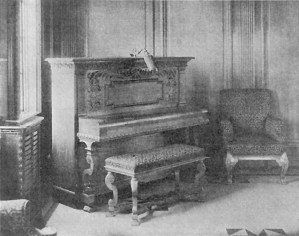
Titanic’s first Model R upright was on the Boat Deck level of the forward Grand Staircase. It was installed against the forward Port side corner, and passengers ascending the top side-flight of stairs would have seen it directly ahead. The bench was upholstered with fabric that matched the chairs.
The other two First Class Steinways were both found on D Deck, the model R upright in the Dining Saloon and the Model B grand just forward in the Reception Room. Both were finished with the same exquisite details, with barley twist legs and marquetry in artfully inlaid wood veneers.
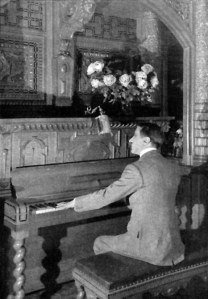
At 6’10.5″, the grand was the crowning glory of Titanic’s pianos, a showcase of workmanship, and it stood out against the white Jacobean walls of the Reception Room. It was located in the forward Starboard corner, almost adjacent to the fanned bottom of the Grand Staircase. The matching music stands stood on barley twist posts. There was also a complementary cabinet for the band’s sheet music storage.
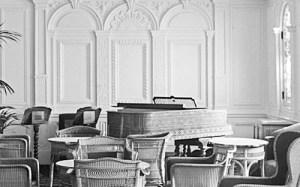

Although it is completely conjecture to say, if the pianos on Olympic are any indication as to the style of Titanic’s pianos, it seems as though the two D Deck pianos, the Reception Room grand and the Dining Saloon upright, were both completed by A. Heaton & Co. Both were finished by craftsmen who possessed the skills to create barley twist legs and designs within the wood veneer. If this is true it means the Model R upright in the First Class Entrance would have been finished by the craftsmen at Harland & Wolff yard.
Titanic was designed to impress, and the pianos played their part to appeal aesthetically to the great expectations of the contemporary world’s wealthy travellers.
Related Posts
- Titanic’s final number: Three Note Theory
- Titanic’s second class pianos
- March 1912: Titanic’s musicians and pianos in place
Links
- RMS Titanic: Five Steinway Pianos for the Ages – Steinway and Sons
- Steinway art case pianos
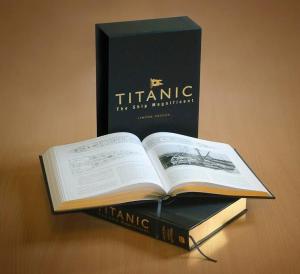
Images from TITANIC The Ship Magnificent, Beveridge, Klistorner, Hall, Andrews. All rights reserved. Many thanks to the authors for permission. Limited Edition here shown (two volumes).
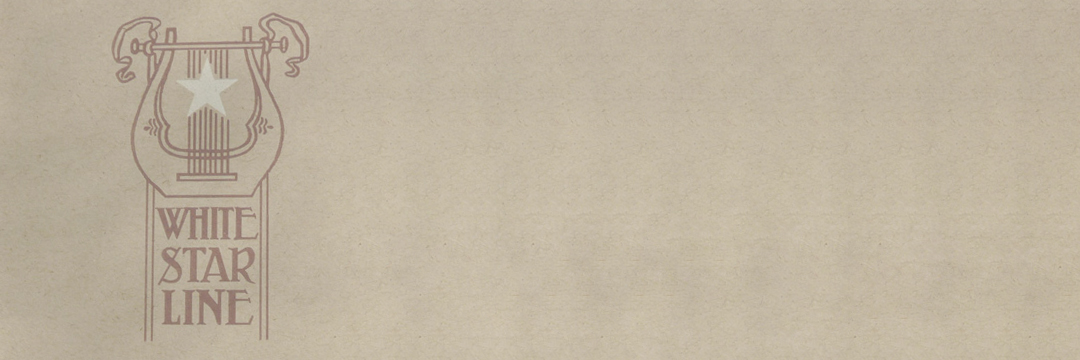


The thing witch intrigued me is the stands form sheets (I don't know how to name it in english, for me, non-english speaking person). There are visible on the photo of reception room, but there are absent on photo showing piano on Boat deck level of first class foyer, where orchestra was performing too. You said, that it is the most probable that musicians performed only with sheets? So why there's no stands for it in foyer? I don't believe they were moving from place to place with these massive stands, which are on the photo of reception rm. Maybe they also had some more handy, portable stands, which they could cerry from place to place. I don't know. (yes, I know, I attach too much importance to details..)
LikeLike
Another photo of the First Class Entrance Hall shows evidence of music stands. They would have been off to the side for the photo shown in this post. Yes, the musicians would have played exclusively with music sheets and would have had music stands at each venue. In First Class the stands were made of wood and appear to have matched the pianos as well as the decor of the rooms.
LikeLike